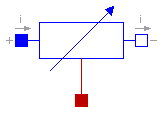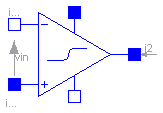 Modelica.Electrical.Analog.Basic.Ground
Modelica.Electrical.Analog.Basic.Ground














This package contains basic analog electrical components:
 Modelica.Electrical.Analog.Basic.Ground
Modelica.Electrical.Analog.Basic.Ground

Ground of an electrical circuit. The potential at the ground node is zero. Every electrical circuit has to contain at least one ground object.
model Ground "Ground node" Interfaces.Pin p; equation p.v = 0; end Ground;
 Modelica.Electrical.Analog.Basic.Resistor
Modelica.Electrical.Analog.Basic.Resistor

The linear resistor connects the branch voltage v with the branch current i by i*R = v. The Resistance R is allowed to be positive, zero, or negative.
| Name | Default | Description |
|---|---|---|
| R | 1 | Resistance [Ohm] |
model Resistor "Ideal linear electrical resistor" extends Interfaces.OnePort; parameter SI.Resistance R=1 "Resistance"; equation R*i = v; end Resistor;
 Modelica.Electrical.Analog.Basic.HeatingResistor
Modelica.Electrical.Analog.Basic.HeatingResistor

This is a model for an electrical resistor where the generated heat is dissipated to the environment via connector heatPort and where the resistance R is temperature dependent according to the following equation:
R = R_ref*(1 + alpha*(heatPort.T - T_ref))
alpha is the temperature coefficient of resistance, which is often abbreviated as TCR. In resistor catalogues, it is usually defined as X [ppm/K] (parts per million, similarly to per centage) meaning X*1.e-6 [1/K]. Resistors are available for 1 .. 7000 ppm/K, i.e., alpha = 1e-6 .. 7e-3 1/K;
When connector heatPort is not connected, the temperature dependent behaviour is switched off by setting heatPort.T = T_ref. Additionally, the equation heatPort.Q_dot = 0 is implicitly present due to a special rule in Modelica that flow variables of not connected connectors are set to zero.
| Name | Default | Description |
|---|---|---|
| R_ref | Resistance at temperature T_ref [Ohm] | |
| T_ref | 300 | Reference temperature [K] |
| alpha | 0 | Temperature coefficient of resistance [1/K] |
model HeatingResistor "Temperature dependent electrical resistor"
extends Interfaces.OnePort;
parameter SI.Resistance R_ref "Resistance at temperature T_ref";
parameter SI.Temperature T_ref=300 "Reference temperature";
parameter Real alpha(unit="1/K") = 0 "Temperature coefficient of resistance";
SI.Resistance R "Resistance = R_ref*(1 + alpha*(heatPort.T - T_ref));";
Modelica.Thermal.HeatTransfer.Interfaces.HeatPort_a heatPort;
equation
v = R*i;
if cardinality(heatPort) > 0 then
R = R_ref*(1 + alpha*(heatPort.T - T_ref));
heatPort.Q_dot = -v*i;
else
/* heatPort is not connected resulting in the
implicit equation 'heatPort.Q_dot = 0'
*/
R = R_ref;
heatPort.T = T_ref;
end if;
end HeatingResistor;
 Modelica.Electrical.Analog.Basic.Conductor
Modelica.Electrical.Analog.Basic.Conductor

The linear conductor connects the branch voltage v with the branch current i by i = v*G. The Conductance G is allowed to be positive, zero, or negative.
| Name | Default | Description |
|---|---|---|
| G | 1 | Conductance [S] |
model Conductor "Ideal linear electrical conductor" extends Interfaces.OnePort; parameter SI.Conductance G=1 "Conductance"; equation i = G*v; end Conductor;
 Modelica.Electrical.Analog.Basic.Capacitor
Modelica.Electrical.Analog.Basic.Capacitor

The linear capacitor connects the branch voltage v with the branch current i by i = C * dv/dt. The Capacitance C is allowed to be positive, zero, or negative.
| Name | Default | Description |
|---|---|---|
| C | 1 | Capacitance [F] |
model Capacitor "Ideal linear electrical capacitor" extends Interfaces.OnePort; parameter SI.Capacitance C=1 "Capacitance"; equation i = C*der(v); end Capacitor;
 Modelica.Electrical.Analog.Basic.Inductor
Modelica.Electrical.Analog.Basic.Inductor

The linear inductor connects the branch voltage v with the branch current i by v = L * di/dt. The Inductance L is allowed to be positive, zero, or negative.
| Name | Default | Description |
|---|---|---|
| L | 1 | Inductance [H] |
model Inductor "Ideal linear electrical inductor" extends Interfaces.OnePort; parameter SI.Inductance L=1 "Inductance"; equation L*der(i) = v; end Inductor;
 Modelica.Electrical.Analog.Basic.Transformer
Modelica.Electrical.Analog.Basic.Transformer

The transformer is a two port. The left port voltage v1, left port current i1, right port voltage v2 and right port current i2 are connected by the following relation:
| v1 | | L1 M | | i1' |
| | = | | | |
| v2 | | M L2 | | i2' |
L1, L2, and M are the primary, secondary, and coupling inductances respectively.
| Name | Default | Description |
|---|---|---|
| L1 | 1 | Primary inductance [H] |
| L2 | 1 | Secondary inductance [H] |
| M | 1 | Coupling inductance [H] |
model Transformer "Transformer with two ports" extends Interfaces.TwoPort; parameter SI.Inductance L1=1 "Primary inductance"; parameter SI.Inductance L2=1 "Secondary inductance"; parameter SI.Inductance M=1 "Coupling inductance"; equation v1 = L1*der(i1) + M*der(i2); v2 = M*der(i1) + L2*der(i2); end Transformer;
 Modelica.Electrical.Analog.Basic.Gyrator
Modelica.Electrical.Analog.Basic.Gyrator

A gyrator is a two-port element defined by the following equations:
i1 = G2 * v2
i2 = -G1 * v1
where the constants G1, G2 are called the gyration conductance.
| Name | Default | Description |
|---|---|---|
| G1 | 1 | Gyration conductance [S] |
| G2 | 1 | Gyration conductance [S] |
model Gyrator "Gyrator" extends Interfaces.TwoPort; parameter SI.Conductance G1=1 "Gyration conductance"; parameter SI.Conductance G2=1 "Gyration conductance"; equation i1 = G2*v2; i2 = -G1*v1; end Gyrator;
 Modelica.Electrical.Analog.Basic.EMF
Modelica.Electrical.Analog.Basic.EMF

EMF transforms electrical energy into rotational mechanical energy. It is used as basic building block of an electrical motor. The mechanical connector flange_b can be connected to elements of the Modelica.Mechanics.Rotational library. flange_b.tau is the cut-torque, flange_b.phi is the angle at the rotational connection.
| Name | Default | Description |
|---|---|---|
| k | 1 | Transformation coefficient [N.m/A] |
model EMF "Electromotoric force (electric/mechanic transformer)" parameter Real k(final unit="N.m/A") = 1 "Transformation coefficient"; SI.Voltage v "Voltage drop between the two pins"; SI.Current i "Current flowing from positive to negative pin"; SI.AngularVelocity w "Angular velocity of flange_b"; Interfaces.PositivePin p; Interfaces.NegativePin n; Modelica.Mechanics.Rotational.Interfaces.Flange_b flange_b; equation v = p.v - n.v; 0 = p.i + n.i; i = p.i; w = der(flange_b.phi); k*w = v; flange_b.tau = -k*i; end EMF;
 Modelica.Electrical.Analog.Basic.VCV
Modelica.Electrical.Analog.Basic.VCV

The linear voltage-controlled voltage source is a TwoPort. The right port voltage v2 is controlled by the left port voltage v1 via
v2 = v1 * gain.
The left port current is zero. Any voltage gain can be chosen.
| Name | Default | Description |
|---|---|---|
| gain | 1 | Voltage gain |
model VCV "Linear voltage-controlled voltage source" extends Interfaces.TwoPort; parameter Real gain=1 "Voltage gain"; equation v2 = v1*gain; i1 = 0; end VCV;
 Modelica.Electrical.Analog.Basic.VCC
Modelica.Electrical.Analog.Basic.VCC

The linear voltage-controlled current source is a TwoPort. The right port current i2 is controlled by the left port voltage v1 via
i2 = v1 * transConductance.
The left port current is zero. Any transConductance can be chosen.
| Name | Default | Description |
|---|---|---|
| transConductance | 1 | Transconductance [S] |
model VCC "Linear voltage-controlled current source" extends Interfaces.TwoPort; parameter SI.Conductance transConductance=1 "Transconductance"; equation i2 = v1*transConductance; i1 = 0; end VCC;
 Modelica.Electrical.Analog.Basic.CCV
Modelica.Electrical.Analog.Basic.CCV

The linear current-controlled voltage source is a TwoPort. The right port voltage v2 is controlled by the left port current i1 via
v2 = i1 * transResistance.
The left port voltage is zero. Any transResistance can be chosen.
| Name | Default | Description |
|---|---|---|
| transResistance | 1 | Transresistance [Ohm] |
model CCV "Linear current-controlled voltage source" extends Interfaces.TwoPort; parameter SI.Resistance transResistance=1 "Transresistance"; equation v2 = i1*transResistance; v1 = 0; end CCV;
 Modelica.Electrical.Analog.Basic.CCC
Modelica.Electrical.Analog.Basic.CCC

The linear current-controlled current source is a TwoPort. The right port current i2 is controlled by the left port current i1 via
i2 = i1 * gain.
The left port voltage is zero. Any current gain can be chosen.
| Name | Default | Description |
|---|---|---|
| gain | 1 | Current gain |
model CCC "Linear current-controlled current source" extends Interfaces.TwoPort; parameter Real gain=1 "Current gain"; equation i2 = i1*gain; v1 = 0; end CCC;
 Modelica.Electrical.Analog.Basic.OpAmp
Modelica.Electrical.Analog.Basic.OpAmp

The OpAmp is a simle nonideal model with a smooth out.v = f(vin) characteristic, where "vin = in_p.v - in_n.v". The characteristic is limited by VMax.v and VMin.v. Its slope at vin=0 is the parameter Slope, which must be positive. (Therefore, the absolute value of Slope is taken into calculation.)
| Name | Default | Description |
|---|---|---|
| Slope | 1 | Slope of the out.v/vin characteristic at vin=0 |
model OpAmp "Simple nonideal model of an OpAmp with limitation"
parameter Real Slope=1 "Slope of the out.v/vin characteristic at vin=0";
Modelica.Electrical.Analog.Interfaces.PositivePin in_p
"Positive pin of the input port";
Modelica.Electrical.Analog.Interfaces.NegativePin in_n
"Negative pin of the input port";
Modelica.Electrical.Analog.Interfaces.PositivePin out "Output pin";
Modelica.Electrical.Analog.Interfaces.PositivePin VMax
"Positive output voltage limitation";
Modelica.Electrical.Analog.Interfaces.NegativePin VMin
"Negative output voltage limitation";
SI.Voltage vin "input voltagae";
protected
Real f "auxiliary variable";
Real absSlope;
equation
in_p.i = 0;
in_n.i = 0;
VMax.i = 0;
VMin.i = 0;
vin = in_p.v - in_n.v;
f = 2/(VMax.v - VMin.v);
absSlope = if (Slope < 0) then -Slope else Slope;
out.v = (VMax.v + VMin.v)/2 + absSlope*vin/(1 + absSlope*noEvent(if (f*vin <
0) then -f*vin else f*vin));
end OpAmp;